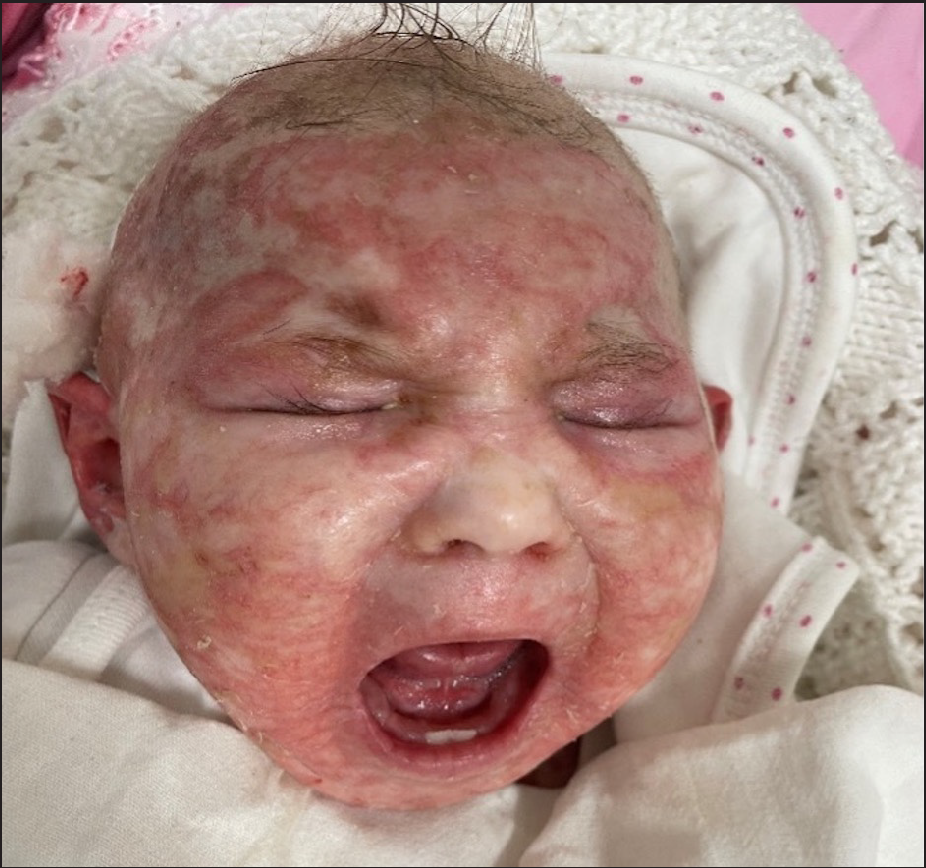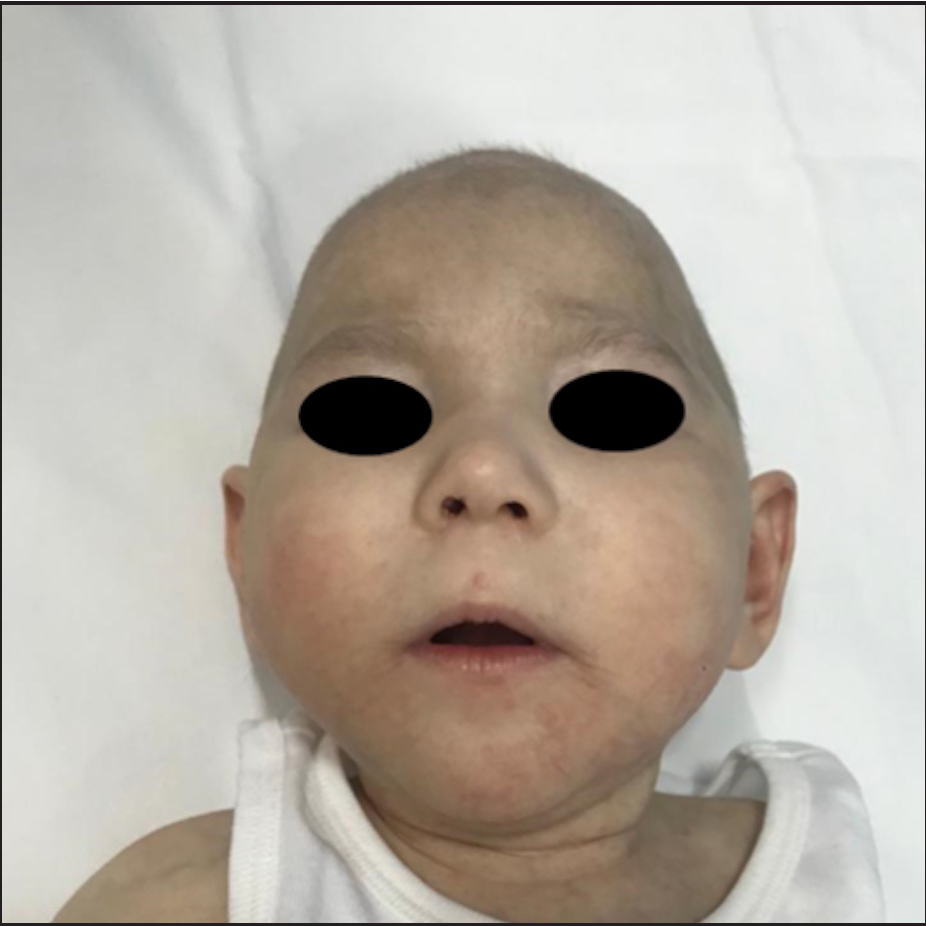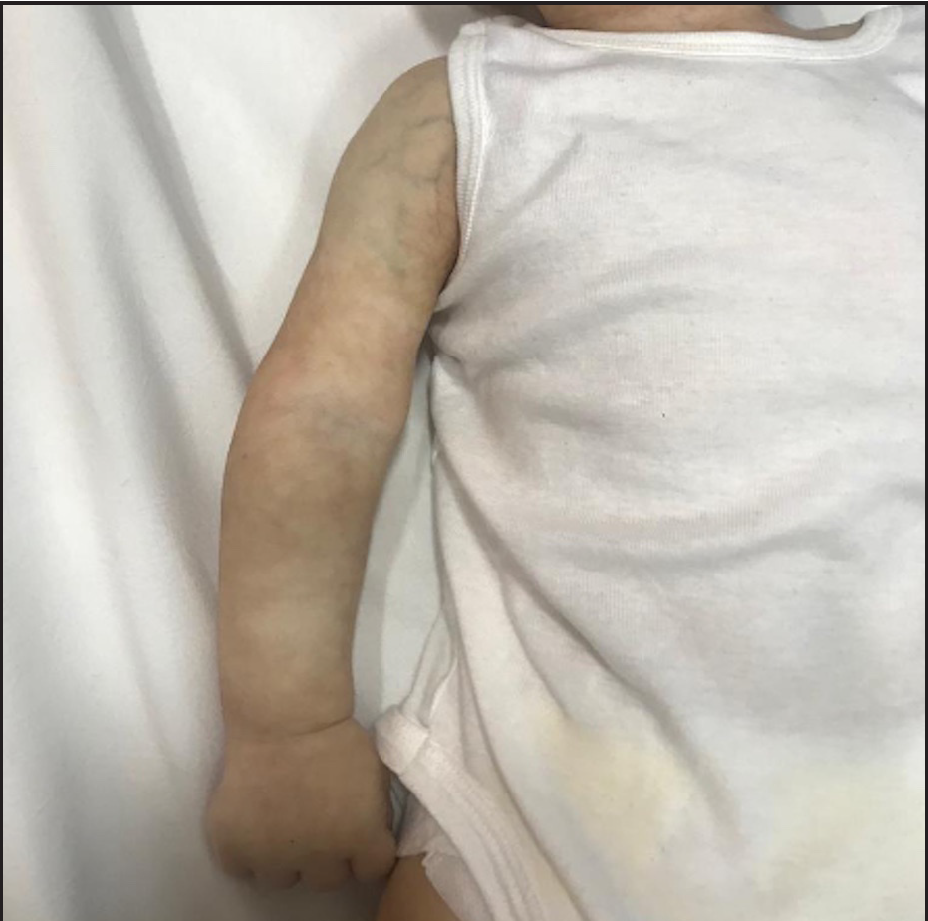Translate this page into:
Acrodermatitis dysmetabolica with argininosuccinate lyase deficiency
Corresponding author: Dr. Ferdi Öztürk, Department of Dermatology, Bursa Uludag University Faculty of Medicine, Bursa, Nilüfer, Bursa, Turkey. ferdiozturk@uludag.edu.tr
-
Received: ,
Accepted: ,
How to cite this article: Öztürk F, Ünlü CI, Sarıcaoğlu H, Aydoğan K, Erdöl Ş. Acrodermatitis dysmetabolica with argininosuccinate lyase deficiency. Indian J Dermatol Venereol Leprol 2023;89:927
Dear Editor,
Argininosuccinic aciduria is an autosomal recessive inherited rare genetic disorder characterised by deficiency or lack of the enzyme argininosuccinate lyase (ASL) which catalyses the fourth reaction in the urea cycle. ASL deficiency (ASLD) is the second most common urea cycle defect.1
Acrodermatitis enteropathica-like condition is caused by acquired zinc deficiency or a disorder of amino acid or fatty acid metabolism and it presents with similar features to acrodermatitis enteropathica. Recently, the term acrodermatitis dysmetabolica was used to describe eruptions that resemble acrodermatitis enteropathica but are caused by dietary deficits other than zinc.2 There are a few cases in literature reporting acrodermatitis enteropathica-like eruptions and most of these are due to the over-restriction of branched chain amino acids in the diet due to amino acid metabolism disorders such as organic acidurias, neonatal citrullinemia,3 ornithine transcarbamylase deficiency (OTC)4 and even cystic fibrosis.5
Here, we report a case with a skin rash similar to acrodermatitis enteropathica with ASLD.
An 18-month-old girl born to non-consanguineous parents, who was diagnosed with ASLD was admitted to the emergency service of our university hospital with complaints of poor general health and recurrent eruptions of 10 days’ duration. The genetic mutation analysis confirmed the diagnosis of ASLD. She was taking a low-protein formula, l-arginine and sodium benzoate. The patient was evaluated in the emergency service. Laboratory studies revealed hyperammonemia (102 µmol/L, normal range 18–72 µmol/L), low levels of the amino acids arginine (8.61 µmol/L, normal range 12–133 µmol/L), isoleucine (12.73 µmol/L, normal range 31–86 µmol/L) and phenylalanine (19.54 µmol/L, normal range 31–75 µmol/L). Serum total protein and albumin levels were low. Arterial blood pH was 7.506 (normal range 7.35–7.45). Dermatological examination revealed erythematous, scaly, slightly oozing plaques with mild erosions on the face, occipital, acral and diaper region, especially in the perioral region, cheilitis, glossitis and brittle hair [Figures 1a, 1b and 1c]. The preliminary diagnosis of acrodermatitis enteropathica, acrodermatitis enteropathica-like eruptions and atopic dermatitis were considered. We suggested that the patient should be checked for serum zinc level, serum alkaline phosphatase (ALP) and a potassium hydroxide (KOH) smear examination for lesions in the diaper region. The patient had been previously diagnosed with ASLD and serum zinc level was normal at the time of diagnosis. Results of the KOH smear were negative. The patient was treated with wet dressing with saline, a moisturizing cream and a combination of fusidic acid and hydrocortisone acetate cream to be applied twice a day for 5 days. We recommended continuing with only fusidic acid cream after 5 days. Necessary dietary supplementation of the patient was made by paediatricians. Two weeks later, the patient’s lesions completely regressed [Figures 2a, 2b and 2c].

- Lesions at the initial evaluation revealed erythematous, scaly, slightly oozing plaques with mild erosions on the face

- Lesions at the initial evaluation revealed erythematous, scaly, slightly oozing plaques with mild erosions on the acral region

- Lesions at the initial evaluation revealed erythematous, scaly, slightly oozing plaques with mild erosions on the diaper region

- Two weeks later lesions on the face were completely regressed

- Two weeks later lesions on the acral region were completely regressed

- Two weeks later lesions on the diaper region were completely regressed
Acquired zinc deficiency is associated with low serum zinc levels and alkaline phosphatase. They are generally normal in acrodermatitis enteropathica-like conditions associated with metabolic disorders.2 Several cases of acrodermatitis enteropathica-like eruptions associated with a raised plasma leucine/isoleucine ratio and/or isoleucine deficiency or valine deficiency, resulting from therapeutic protein restriction diets with different aminoacidopathies, have been described in infants.2 In our patient, serum zinc level measured in the first month was normal and the initial symptoms appeared even though the zinc level was normal. Nevertheless, when the patient was consulted, serum zinc and albumin levels were low and ALP was normal. Serum zinc level is affected by some factors such as age and serum albumin level. The serum zinc level of our patient may have been found to be low due to the low albumin value. Since albumin is the main transporter of serum zinc, patients with hypoalbuminemia may have low serum zinc. The protein restriction imposed on our patient to treat her ASLD led to abnormally low levels of the amino acids arginine, isoleucine, and phenylalanine which are known to be essential components of epidermal keratins. Our patient’s skin lesions improved with replacement of arginine and a reduction in the severity of her protein restriction allowed arginine, isoleucine and phenylalanine levels to normalise. There have been several reports of acrodermatitis enteropathica-like eruptions in association with inborn errors of the urea cycle, in citrullinemia associated with argininosuccinate synthase deficiency and in carbamoyl phosphate synthetase deficiency, as well as in OTC deficiency.2 An acrodermatitis enteropathica-like eruption due to ASLD has not been reported before. In conclusion, ASLD should be considered along with other urea cycle defects in the differential diagnosis of an infant with acrodermatitis enteropathica-like eruptions.
Declaration of patient consent
Patient’s consent not required as patients identity is not disclosed or compromised.
Financial support and sponsorship
Nil.
Conflict of interest
There is no conflict of interest.
References
- Argininosuccinate lyase deficiency. Genet Med. 2012;14:501-7.
- [CrossRef] [PubMed] [PubMed Central] [Google Scholar]
- Acrodermatitis enteropathica-like eruption in metabolic disorders: Acrodermatitis dysmetabolica is proposed as a better term. Pediatr Dermatol. 2009;26:150-4.
- [CrossRef] [PubMed] [Google Scholar]
- Neonatal citrullinemia: Treatment with keto-analogues of essential amino acids. J Pediatr. 1977;90:218-24.
- [CrossRef] [PubMed] [Google Scholar]
- A case of acrodermatitis enteropathica-like dermatosis caused by ornithine transcarbamylase deficiency. J Am Acad Dermatol. 2002;46:965-7.
- [CrossRef] [PubMed] [Google Scholar]
- Acrodermatitis enteropathica-like eruption as the presenting sign of cystic fibrosis - Case report and review of the literature. Eur J Pediatr. 2002;161:475-8.
- [CrossRef] [PubMed] [Google Scholar]





